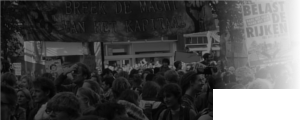

Reageer op:
Analyse USA verkiezingen
ma, 12/11/2012 - 09:24 — nnHier kun je discussieren over Analyse USA verkiezingen.
In dit artikel worden interessante feiten genoemd
voor hen die daarin interessse tonen.
Enkele stukken tekst:
An initial analysis of the results of Tuesday’s presidential election reveals one overriding element
that is little noted in the American media: the staggering decline in voter turnout,
and in particular the vote for President Barack Obama. More than anything else,
the vote is the expression of an electorate that is disillusioned and increasingly alienated
from the entire two-party political system.
In fact, Obama saw a substantial drop in his vote across the board, with millions
more Americans choosing not to vote in this election. Little remains of the enthusiasm of 2008,
when Obama was swept into power on a wave of popular hostility to the Bush administration.
Obama’s total vote count was approximately 9 million less than what he received in 2008,
falling from 69.5 million to 60.5 million, or by about 13 percent.
For his part, Romney pulled in only 57.5 million votes, about 2.5 million less than John McCain in 2008.
That is, Obama just barely received more votes than his Republican challenger four years ago.
The elections were characterized by a massive infusion of billions of dollars,
with endless advertisements and media commentary over the course of nine months.
The past four years have seen a significant growth in the number of eligible voters.
However, in the end, the number of people voting fell by about 11 million.
Particularly striking in California, a bastion of the Democratic Party,
the total vote fell from 13.2 million in 2008 to only 9.2 million in 2012,
with Obama receiving in that state more than a million fewer votes
than the Democratic candidate in 2004, John Kerry.
Turnout declined in every state, according to Curtis Gans
of the American University’s Center for the Study of the American Electorate.
“This was a major plunge in turnout nationally,” he noted.
The sharp fall in Obama’s vote as he won his second term is virtually unprecedented
in the history of American politics.
It is in fact exceedingly rare for a president
to win a second term with less votes than in the first election.
George W. Bush, for example, increased his vote from 50 million in 2000 to 62 million in 2004.
Clinton increased his vote from 45 million in 1992 to 47.5 million in 1996.
Reagan increased his vote from 44 million in 1980 to 54.5 million in 1984.
Indeed, the last time that a president won reelection with a decline in his popular vote
came in the elections of 1944 and 1940, as Franklin Delano Roosevelt
saw his enormous advantage over his Republican challengers fall somewhat in his bids for third
and fourth terms after his landslide election in 1932.
However, a comparison to Roosevelt’s votes is itself instructive in understanding
the scale and significance of Obama’s decline. In 1936,
Roosevelt was elected to a second term in the midst of the Great Depression,
seven years after the Wall Street crash of 1929. In that election,
FDR increased his popular vote from 23 million to 28 million,
a growth of more than 20 percent. His Republican challenger,
Alf Landon, won only 36.5 percent of the popular vote, carrying just two states,
Vermont and Maine, for a total of eight electoral votes.
In the next two elections, Roosevelt’s total vote fell to 27.3 million and then 25.6 million.
As with FDR, Obama was elected under conditions of deep economic and social crisis,
taking over from the most hated president in US history, George Bush.
However, in four years he managed to almost entirely dissipate
whatever advantage he had over his Republican challengers.
